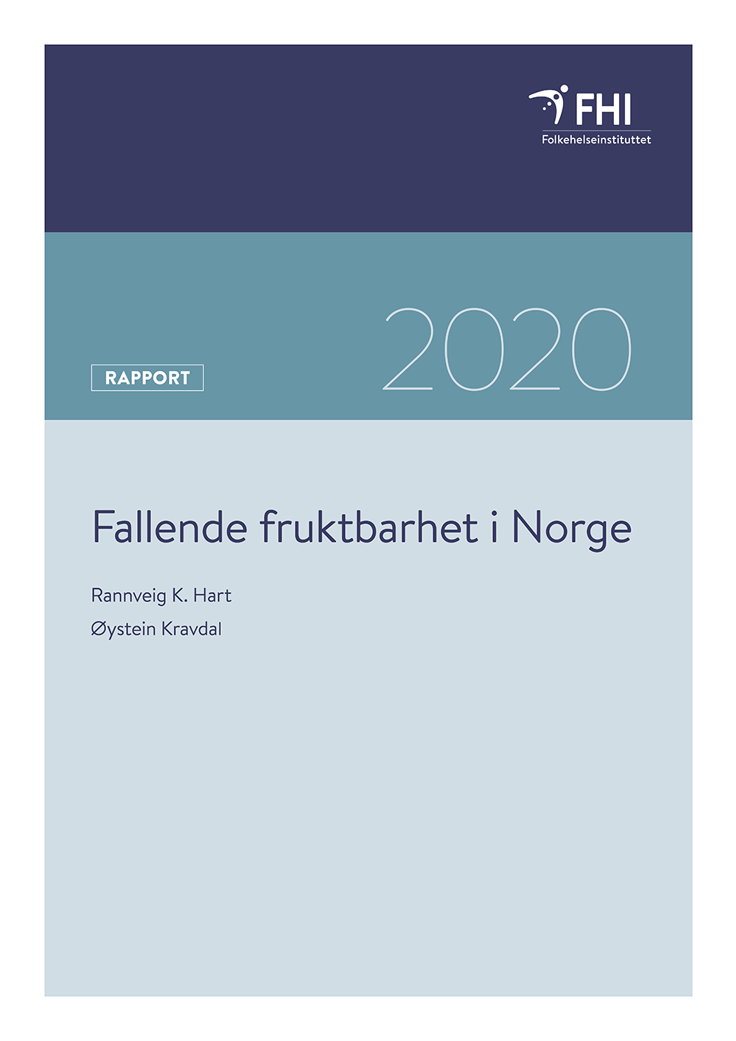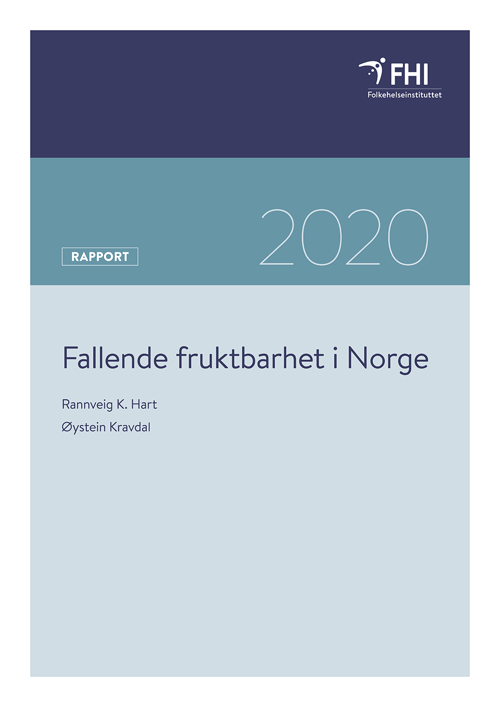Fertility decline in Norway
Report
|Published
|While the total fertility rate was 1.98 in 2009, it was only 1.56 in 2018. This decline is in particular a result of increased childlessness, higher age at first birth, and a smaller proportion of two-child mothers having a third child. However, it should be noted that women who were 45 years old in 2018 had as many as 1.98 children on average. Conclusions from five subprojects are summarized and discussed in the report.
Download
Key message
This report summarizes the results from five research projects on fertility in Norway.
After 2009, Norway and other Nordic countries, and all main educational groups within these countries, have experienced almost the same fertility decline. Such parallel trends - although the countries were hit differently by the «financial crisis» and have had different economic development - may suggest that the reduction of fertility is not a result of changes in people’s actual economic situation. However, a generally stronger feeling of economic uncertainty may have played a role.
The fertility decline has not been particularly sharp among people who appear to have relatively poor health.
Changes in values may have contributed to the development, but it is particularly difficult to establish solid evidence of this.
Our review of existing research and the survey we conducted among Norwegian women and men indicated that it may be possible to increase fertility – should that ever be wanted – by reducing the costs of childbearing. For example, it is possible that even lower prices for day care and after-school care may stimulate childbearing. Larger cash benefits to parents may also have an impact. The survey indicated that longer parental leave, shorter normal working time with full wage compensation for parents, an additional vacation week, and more flexible work schedules may increase fertility, but such effects are not yet shown in good statistical studies.
Summary
The project «Causes of the fertility decline» was carried out in 2019 and financed by the Ministry of Children and Families, Ministry of Health and Care Services, Ministry of Labour and Social Affairs, and Ministry of Education and Research.
The project has consisted of five subprojects involving researchers at the Norwegian Institute of Public Health, Statistics Norway, the Institute for Social Research and the University of Oslo. The work has been co-ordinated by the Centre for Fertility and Health at the Norwegian Institute of Public Health. In this report, the conclusions from the five subprojects are summarized and discussed. Detailed accounts of the results and the statistical methods that have been used can be found in separate reports or research articles from each of the subprojects.
The ministries’ interest in funding this research was triggered by the strong decline in the so-called “total fertility rate” (which may be seen as a snapshot of fertility) over the last ten years. While the total fertility rate was 1.98 in 2009, it was only 1.56 in 2018. This decline is in particular a result of increased childlessness, higher age at first birth, and a smaller proportion of two-child mothers having a third child. However, it should be noted that women who were 45 years old in 2018 had as many as 1.98 children on average. The number of children that women have had by age 45 will probably be lower for those born in later years, but may never go down to 1.56. During periods when the age at birth increases, the total fertility rate is considerably lower than the number of children women actually end up with.
At the outset, it would seem likely that several economic, political or ideational factors may have contributed to the fertility decline. Unfortunately, we cannot clearly identify any particularly important driving forces, but one of the subprojects suggests that the decline is not a result of economic problems experienced in the wake of the “financial crisis”. To the extent that the financial crisis has contributed, it is rather by creating a general feeling of economic uncertainty, regardless of the individuals’ actual economic situation. The basis for this idea is that the fertility development has been quite similar across the Nordic countries, and in all educational categories, although these have been influenced differently by the financial crisis.
Another subproject showed that the reduction of fertility has not been particularly sharp among people with poor health, according to indicators based on sickness absences and long-term sickness benefits. If it is the case that the country’s economic development or other factors have led to expectations about more intensive work efforts, one might believe that this group would find it particularly problematic to work full-time while having responsibility for young children – and thus incur a particularly large loss of income (i.e. indirect cost) as a result of childbearing.
The survey we carried out supported the idea that economic security increases the probability of having a child. In accordance with this, the respondents also said that high costs of childbearing was one reason why they did not want more children (in addition to burdens associated with sleep deprivation, pregnancy and delivery, and worries about the potentially adverse consequences for older siblings).
Our review of existing research showed that some policies that help to reduce the childbearing costs probably have contributed positively to fertility. However, there have not been any changes in family policies that can explain the fertility decline over the last years. Should there ever be a desire for higher fertility or preventing further decline, some policies that seem to have had impact in various countries earlier may be considered. These policies can be grouped into four main categories: subsidized child care, “paying” parents to take care of their own children, cash benefits to parents, and health care services.
By paying for child care it is possible for the parents to be employed. Earlier studies indicate that good access to day care centres and low price for this service may have positive effect on fertility. There is already very good access to day care centres and after-school care in Norway, but further reduction of the prices might stimulate childbearing. The survey pointed in the same direction, because many respondents said that they might have had more children if day care centers and after-school care had been free.
The possible effects of the length of the parental leave, and how this is distributed between the mother and father, have attracted much public and political debate. Our review of existing literature showed that there is no basis for claiming that the father quota affects fertility. There is more uncertainty about the impact of a potential expansion of the total leave. In the survey, however, a common answer was that a longer leave might have led to higher fertility.
Furthermore, a considerable proportion of the survey respondents, and in particular women with children, said that they might have had more children in a society with shorter normal working time for parents (with corresponding increase in the hourly wage so that the full-time income would remain unchanged), an additional vacation week, and more flexible work schedules. Unfortunately, there have so far not been any studies evaluating the effects of such policies.
Our literature review also showed that cash benefits may contribute to higher fertility. However, such benefits may conflict with another political goal – maintaining high employment among mothers. A possible solution to this conflict is to provide cash benefits in the form of tax deductions, although the possible distributional implications of such a policy should ideally first be evaluated.
Additionally, the literature review indicated that lower costs of assisted reproduction may push fertility upwards. However, this conclusion is based on a small number of studies, and even if there is an effect in the countries that have taken such a step, the relevance for Norwegian fertility is probably modest. The proportion who are sub- or infecund is not very high, and many of them already have access to highly subsidized public health care services.
The fertility decline is probably not only a result of economic factors. In particular, there may have been changes in people’s ideas about how important family and children are compared to what one may alternatively spend time and money on. We have not had access to data that can shed light on this, but have documented associations between fertility, religiosity and other value indicators, and have shown a moderate decline in religiosity measured by the proportion believing in God.
At the end of the report, we discuss some other factors that, in principle, may affect fertility, and that we have not analysed. Some of the changes that have taken place in these respects may have contributed to the fertility decline, perhaps especially the reduction in part-time work and in the proportion of the youngest who have a partner.
Register data from Norway and other Nordic countries are highly valuable when examining certain hypotheses about factors underlying the fertility development, or when estimating effects of family policies. However, it would be a great advantage if they could be supplemented with surveys where people are explicitly asked about their reasons for not wanting to become a parent (yet) or have more children. If such surveys had been conducted in, for example, 2009 and 2018, we could have compared the answers and gained more insight into the reasons for the fertility decline. Similarly, if such surveys are conducted regularly in the coming years, we will be better equipped to understand future fertility changes.

